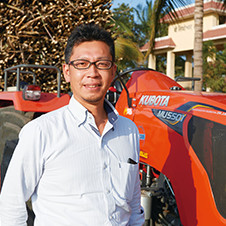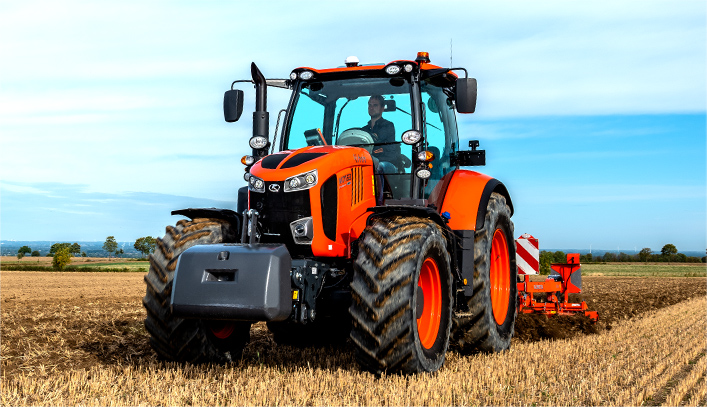02
Kubota’s Local Community-Based Strategy: The Multi-Purpose Tractor

Major project starts up: Introducing a new type of tractor to the Indian market
Kubota entered the Indian market in 2008, rather late for a leading Japanese agricultural equipment manufacturer with strong footholds in the global markets stretching from Europe to North America and Asia. The reason for the delay in Kubota's entry to the Indian market was the desire to wait until it had tractors that were adaptable not only to rice cultivation but also to various upland farming applications. The advantages that Kubota's small, light and compact tractors provided to rice farming were not as well suited to the needs of the Indian market, so the company turned its attention to developing a tractor that would conform to Indian specifications. In fact, by the time KAI was established, Kubota had already started working on the conceptual design of the new, MU5501 multi-purpose tractor. With the goal of introducing an entirely new tractor to the market instead of merely competing with existing products, this major project was both challenging and groundbreaking.
-

Applications of the multi-purpose tractor is quite diverse. -

Applications of the multi-purpose tractor is quite diverse. -

Applications of the multi-purpose tractor is quite diverse. towing a rice stem harvester. -

Applications of the multi-purpose tractor is quite diverse. also used as power source for combines.
Small tractors create a new market Kubota brand starts to penetrate
KAI's initial priority before launching the MU5501 was to increase Kubota brand recognition across the Indian market. KAI headed to India's southern regions to introduce the mediumsized L series, a major player in the Kubota product lineup, and then brought the smaller B-series to the fruit market in the western regions. Although the work efficiency of the lightweight 4WD tractors in the L-series was highly praised in the wet paddy regions, the series fell short of satisfying user need for multiple applications such as upland fieldwork and trailer towing, which account for the majority of use in India. As a result, L-series tractor sales were limited. On the other hand, the small, high-power B-series tractors were highly valued in cultivation management for sugar cane and cotton, and especially prized in grape control work as its features enabled uniform and highly efficient insecticide spraying. These advantages contributed directly to improved crop quality and increased exports, which led to increased profits and helped the B-series succeed in creating a new market as it became a pillar of the agricultural equipment business in India. This new business model had an impact on the market and other manufacturers soon followed. The success of the B-series provided a solid foundation for the introduction of the new MU5501, and became the driving force behind Kubota's slow, but steady penetration into this important market. Kubota's dealer network, vital to sales, was also expanded, as the environment for introducing the new tractor was steadily developed.
-

A B-series tractor being used for control work in a vineyard. The high evaluation of this tractor led to the development of the Indian market.
Market research with a market-in approach Development concept: Durability, operability and fuel efficiency

Tractor and Utility Machinery Sales Dept.
In 2012, Kubota launched a development project for the new tractor, including full-scale research on and analysis of the Indian market. Kubota has always excelled in clearly grasping user needs and reflecting them to product development, and this approach was emphasized even more for the Indian market. Kubota adopted a marketbased, or “market-in” approach. One of the people in charge of marketing was Shintaro Seshimoto of the Tractor and Utility Machinery Sales Department.
“Our mission was to thoroughly listen to the target users, the farmers themselves, and to identify the specific kind of tractors that they were looking for. We made it a point to clear the slate of past examples and apply a multifactorial approach to analyze the needs of the Indian farmers. I think we interviewed more than 200 individuals.”
The market-in approach showed the team that the user needs for tractors in India were completely different from those in the rice growing markets where Kubota had been successful. One significant difference is that people in India make full use of tractors all year round for daily transportation, cargo and light civil engineering work. Their tractors also get quite a workout. It's not uncommon to see a tractor with its front wheels off the ground towing an overloaded trailer; and tractors are commonly used as a power source for the harvesting and driving functions of combines, a use that is unique to India. The team found that high traction was an essential element for Indian users. It also became clear that fuel economy was a major concern because tractors are used in all aspects of daily life; and this in turn made high operability to reduce fatigue an important concern. As these findings were accumulated, the concept of the new tractor gradually began to take shape.
“Based on the results yielded by the market research, the concept of the new model was a tractor that would surpass the fuel efficiency, durability, and operability of tractors made in India, deliver the same traction, and not exceed the standard weight or vehicle classification.” (Seshimoto)
Kubota has wonderful opportunities to strengthen the identity of its tractors in unchartered territory

Director, Coordinator Sales Management & Planning Sales Management & Planning Division
Kubota Agricultural Machinery India Pvt. Ltd.
At the same time, Yoshiaki Fujii, the current Director of Sales Management & Planning at KAI, was analyzing the Indian market from Japan.
“Kubota has strong brand value in Europe, North America and Southeast Asia, but nobody knew the brand here in India. Furthermore, India is a vast federal republic of 29 states, each with its own language, culture and customs. Complicating matters was the fact that our small, light and compact tractors were not quite suited to farmer needs here. The most valued feature in India was traction power, which requires a heavier rather than lighter body weight. Kubota found itself facing a difficult challenge in uncharted territory.”
To highlight the new 55-horsepower model's versatility in meeting user needs in India's high-end class market, it was named the “Multipurpose Tractor” and assigned the product code “MU5501.” This venture into unchartered territory, as Fujii put it, then advanced to specific development phases in the hands of Kubota engineers. However, a tough hurdle was awaiting them just ahead, and overcoming that hurdle to bring the project to fruition required the full effort and determination of the engineering department.
-

A multi-purpose tractor being used in ground leveling work in a sugar cane field.
